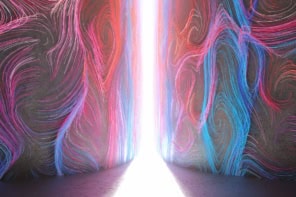Physicists in the US are the first to demonstrate the quantum-mechanical phenomenon of entanglement in a common physical system known as a mechanical oscillator. The team has entangled the vibrational states of two pairs of atomic ions in an experiment that is another step forward in our understanding of the boundary between the quantum and classical worlds.
Since the birth of quantum mechanics in the 1920s and 1930s, physicists have argued about the relationship between the probabilistic domain of atoms and molecules and our everyday world of concrete objects. The problem was most famously highlighted by Erwin Schrödinger when he imagined the fate of a cat enclosed in a sealed box with a tiny quantity of radioactive substance placed near a Geiger-counter-enabled hammer and a glass flask of poison. Quantum mechanics suggests that after a certain period of time — at which point there may or may not have been a radioactive decay, causing the poison to be released — the cat is in a superposition of alive and dead states.
No one, however, has ever observed a cat or any other large object in such a superposition. It is possible that this is simply a technical issue, and that we are not yet able to isolate large objects from the environment for long enough to observe their fragile quantum states. Alternatively, there could be a fundamental, but as-yet undiscovered, mechanism that restricts quantum-mechanical effects to systems below a certain size.
Quantum effects in bigger systems
In the last decade or so, researchers have seen quantum effects in systems approaching the size of objects that normally obey classical physics. These have included quantum interference between beams of carbon-60 molecules, and a superposition of electrical currents circulating in opposite directions around a ring of superconducting material. However, no one has thus far observed entanglement — which gives two or more entities a much closer relationship than allowed by classical physics — in mechanical oscillators.
These are vibrating systems that include an oscillating mass on a spring, a plucked violin string and the vibrations of atoms in a molecule. When the energy of oscillation is extremely low the system’s energy levels become quantized and the motion is then described by the superposition of different quantum states. The simultaneous superposition of states from several oscillators leads to so-called entangled states, in which the properties of the constituent oscillators are correlated in ways not described by classical physics.
Now, John Jost and colleagues at the US National Institute of Standards and Technology (NIST) in Boulder, Colorado have entangled two oscillators by placing four ions — two beryllium-9 ions and two magnesium-24 ions — in the potential well of a single electrode (arXiv:0901.4779).
They then entangled the internal states of the two beryllium-9 ions and separated the four ions into two pairs, each containing one ion of each kind. This was done by placing the pairs next to two different electrodes. In this way, each pair acted as if it were a distinct mechanical oscillator, composed of two masses connected by a spring about 4 μm, with the two pairs separated by a distance of 0.24 mm.
’Non-locality’ could be studied
To entangle the mechanical oscillators, the team used laser beams to transfer the entanglement from the beryllium-9 ions’ internal states to the motion of the separated ion pairs (with the ions in each oscillator vibrating out of phase with one another). They were able to maintain this entanglement for around 100 μs.
Jost and team report that their work extends “the regime where entanglement has been observed in nature”, and that it could be used to investigate “non locality”, the interdependence of measurements carried out at two different places simultaneously. They also claim that their experimental technique “represents an important step towards large-scale trapped-ion quantum information processing”.



